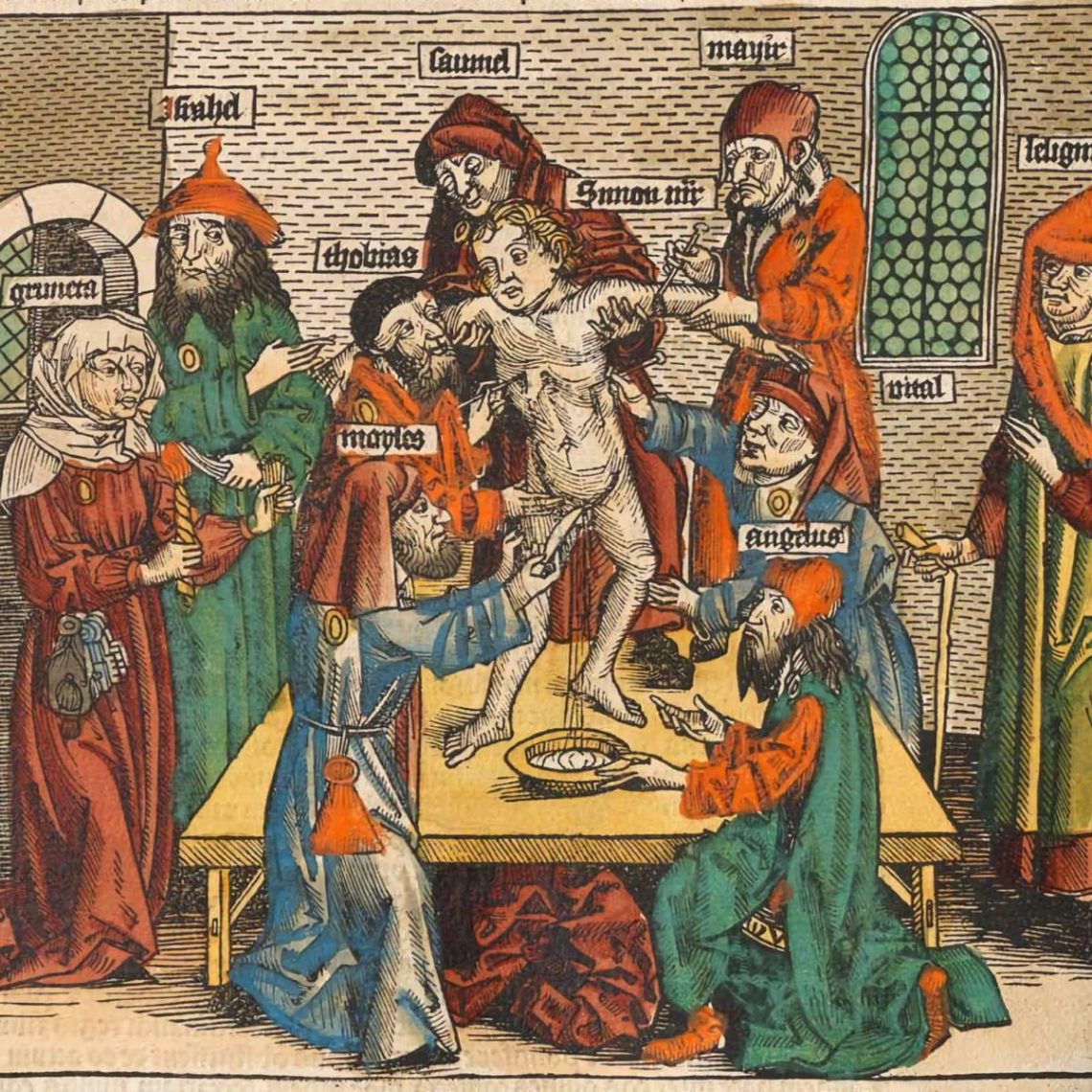Harry Storm
If anyone had doubts that Israel has become the “Jew among nations,” the intensity of hatred directed at the Jewish state over its war with Hamas should dispel them. This odd reaction to the war in Gaza, which Hamas initiated by invading southern Israel and slaughtering 1,200 Israelis, is more understandable, though not excusable, if one considers that Israel has also become the latest iteration of the “collective Jew.”
The notion of the collective Jew, which considers Jews as a kind of hive mind without significant individual differences, is a fantasy. Nonetheless it inspired non-Jews throughout the centuries, including the authors of the Gospels, early Christian leaders, medieval monarchs and even William Shakespeare, when describing the motivations and actions of Jews (real and fictional) of their time.
Since Oct. 7, I’ve been trying to understand why so many, especially but not exclusively on the left, continue to believe all utterances by Hamas and dismiss any Israeli claim or denials as baseless propaganda. After all, not only did Hamas initiate the current conflict by slaughtering hundreds of Israeli civilians on Oct. 7: Hamas leaders have made it perfectly clear that if they are able to continue ruling Gaza, they intend to do the same “again and again.”
Hamas has also been caught with its pants on fire making fantastically false claims, for example that Israel bombed the Al-Ahli hospital in Gaza City, killing 500 people, including physicians and patients. In fact, it was a misfired Palestinian Islamic jihad missile, it landed in the hospital’s parking lot, and few if any individuals were killed.
But this doesn’t seem to matter. Much of the Western world accepts Hamas’ claims while rejecting Israel’s, particularly with regard to civilian casualties in Gaza and the amount of aid that is entering the Strip. And far too many people demonize Israel as a uniquely evil force that must be dismantled or eradicated.
So how is it that a terrorist group with a medieval mindset and murderous intent gets the benefit of the doubt from so many in the West, whereas Israel, a modern democratic state with freedom of the press, does not?
For some especially on the far right and far left, the reason could be garden-variety antisemitism. But that doesn’t explain why so many millions in the West – though thankfully, not the majority – are so readily persuaded that Israel is primarily responsible for the Gaza War and the Israel/Palestine quagmire in general. After all, many of these same people have longstanding and close relationships with Jews whom they admire and love. So why do they consider Israel to be so untrustworthy and unworthy of the benefit of the doubt?
One answer, I believe, is that as the latest version of the collective Jew, Israel has the same qualities as its previous iterations. In the past, Jews have been seen as scheming Elders of Zion, greedy and grasping moneylenders, and Christ killers (the original).
These toxic fictions have been imbibed by generations of non-Jews for centuries, and although their cultural impact has lessened in modern times they have never dissipated entirely. If one views Israel through this distorted lens, it is just as nefarious as the previous versions of collective Jew, and therefore deserves to be eradicated.
In the New Testament, the Jews are collectively blamed for Jesus’ death, including all succeeding generations. In Matthew 27;25, after the Roman procurator, Pontius Pilate, “washes his hands of Jesus’ fate, the Jews are said to declare: “His blood be on us and on our children,” which later Christian theologians took to mean that all Jews – not just those present at the trial — were collectively responsible for Jesus’ death – for all time.
Several hundred years after Matthew declared all Jews Christ-killers, the medieval Christian world came to see the collective Jew as a moneylender, even though it’s virtually impossible that all or even most of the Jews of medieval Europe, estimated to number 150,000 in the year 1170 and 450,000 in 1300,1 could have been moneylenders. Some were, of course, because moneylending was one of the very few occupations open to them (only because Christians weren’t allowed to lend at interest to other Christians), but the majority of Jews, particularly those in walled ghettos, had other occupations, including being merchants, artisans and physicians. It’s also estimated that as late as 1170, 5-10 percent of Jews still farmed2 the land.
Still, the greedy, grasping Jewish moneylender was etched into the collective gentile memory. For example in Shakespeare’s The Merchant of Venice, Shylock, a Jewish-Italian moneylender, wants to extort ‘a pound of flesh’ for an unpaid loan and values his jewels more than his daughter. Although Shylock is just one fictional character, to the non-Jewish mind of the time, he symbolized all Jewry, in much the same way as the Gospel of Matthew turns the Jewish multitude watching Jesus’ trial into all Jews, both present and future.
Wilhelm Marr, who in 1879 founded the League of Antisemites in Germany, was clearly alluding to the collective Jew when he railed against “Jewry’s control of society and politics”3 and described Jews as a “flexible, tenacious, intelligent foreign tribe that knows how to bring abstract reality into play in many different ways. Not individual Jews, but the Jewish spirit and Jewish consciousness have overpowered the world.” Marr’s belief in Jewish “spirit and consciousness” – what he called “Semitism” – characterized the collective Jew and were the basis and justification for “antisemitism,” the term he invented (and was meant specifically for Jews, not speakers of other Semitic languages, such as Arabic).
The Nazis, Marr’s successors in the 20th century, took his ball and ran with it. For example, the Nazi film Jud Suss, also nominally about one Court Jew of the 18th century, in fact was meant to represent (and besmirch) all of European Jewry, because Nazi antisemitism could not conceive of Jews as anything but a collective – all Israels and Sarahs — that had to be exterminated.
In this the Nazis were influenced not only by Marr and other German anti-Semites of the 19th century such as the German composer Richard Wagner (who viciously turned against his Jewish mentor, Giacomo Meyerbeer), but also by The Protocols of the Elders of Zion, a fabricated document created in Tsarist Russia at the start of the 20th century. Interestingly, like the notion of the collective Jew, this anti-Jewish concoction lives on in the minds of anti-Semites worldwide despite being utterly discredited.
Since the end of the Second World War, active discrimination against Jews eased further, so much so that by the 1970s, in some countries at least, prejudice against Jewish individuals seemed mostly a thing of the past. Today, in the West, Jews aren’t collectively blamed for the crimes of a single Jew, whereas in previous generations, when crimes or other sordid activities were exposed, Jews would hope that a Jew wasn’t involved so that the community wouldn’t be targeted.
Most Christian denominations no longer believe Jewish people are nefarious, untrustworthy, or deceitful. But that is how many of those same denominations describe the actions of Israel. This transition from Nazi-style collectivization of Jews to Israel becoming the collective Jew among nations took several decades, in part because of what the surviving Jews had gone through during the holocaust and because of Israel’s original underdog status.
But after the quick victory against its Arab neighbours in the 1967 six-day war, Israel increasingly was seen as manipulative, untrustworthy, and also, because of its military prowess, aggressive and colonialist.
As one might expect, what starts with Israel often ends up impacting Jews around the world, which is precisely what is happening currently on campuses and on the streets of most Western countries. This phenomenon isn’t new: In 2002, the Swedish former deputy prime minister, Per Alhmark wrote that “Although the state of Israel… is the object of a ‘new antisemitism’, the effects are felt by Jews and Jewish communities everywhere. ..It [contemporary antisemitism] attacks primarily the collective Jew, the State of Israel. And then such attacks start a chain reaction of assaults on individual Jews and Jewish institutions.”
As Ahlmark predicted, the targeting of Israel in the aftermath of the Oct. 7 massacre, has led to a surge of antisemitism so virulent that most Jewish institutions are now on high alert and individuals who are visibly identifiable as Jews risk facing verbal and sometimes physical abuse.
To avoid being targeted, some Jews conclude that ‘if you can’t beat ‘em, join ‘em” and renounce their Jewishness to detach themselves from the Jewish community. The strategy hasn’t always worked, however; for example, in 15th-century Spain, New Christians –Jews who converted to Christianity – were so distrusted that an inquisition was established to root out “secret Jews” who continued to practice Judaism.
Today’s version of “Do you accept Jesus Christ as your lord and savior?” is “Are you a Zionist?” I suppose it’s a small measure of human progress that Jews are no longer burned at the stake for giving the wrong answer.





